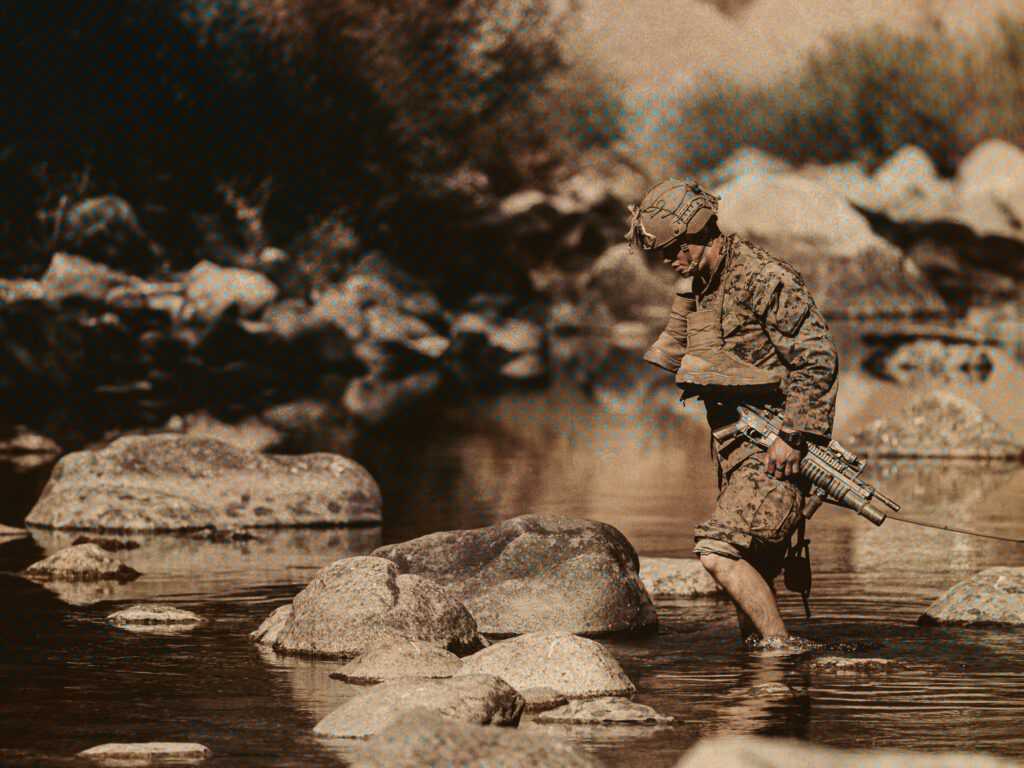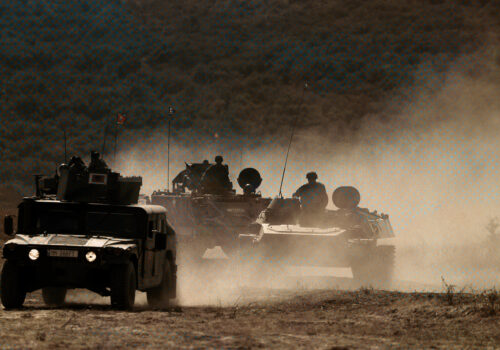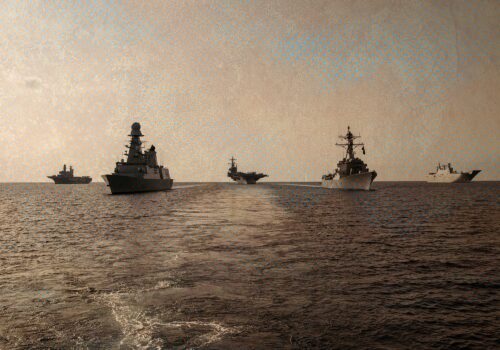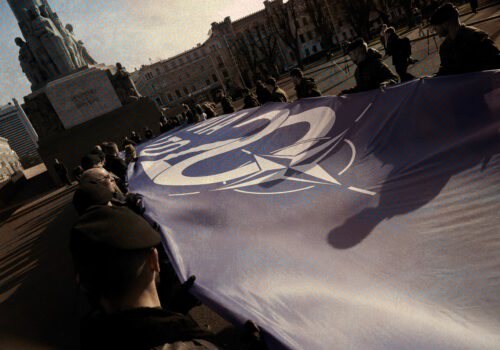At the NATO Summit in Washington summit last month, the United States and its allies reiterated the Alliance’s ambitious commitment: to become “the leading international organisation for understanding and adapting to the impacts of climate change and extreme weather on security.” The goal stems from a growing awareness among many about how climate change is shaping NATO’s ability to deter and defend. Wildfires are disrupting training and military exercises, while extreme heat has contributed to soldiers’ deaths and rendered multimillion dollar equipment nonfunctional. Rising sea levels threaten naval bases and other critical infrastructure, while warmer air is impeding the performance of aircraft, including rotorcraft. What has the Alliance done so far to counter these threats, and what steps will incoming Secretary General Mark Rutte and allies need to take to ensure NATO can deliver on this commitment?
As part of an ongoing project, we have been seeking to answer these and related questions about NATO’s adaptation to climate change. To do so, we have thus far interviewed sixty-three political and military officials from allied delegations and other offices from sixteen member states across all of NATO’s geographic regions. Our project, which began in the spring of 2023, is funded by the University of California Institute on Global Conflict and Cooperation (IGCC).
While our analyses are still underway, we heard several themes emerge from our interviews. Almost all officials acknowledged climate threats as important. But many framed these as long-term threats, rather than immediate ones, and a handful of officials were dismissive of the issue as a priority. Few officials maintained the belief that human-made climate change is not a real phenomenon. Some officials viewed climate issues as not particularly relevant to NATO’s everyday work. For some with climate security in their portfolios, it could be difficult to convince colleagues to devote political capital to it.
Repeatedly, we heard about a widely perceived tradeoff between investing in climate adaptation or mitigation measures and investing in deterrence—particularly in the context of Ukraine. Many officials reported that the war in Ukraine had shifted the focus from a broader climate security agenda to one more narrowly focused on energy security. We were also told that some colleagues feared that elevating climate security would come at a cost to operational effectiveness. At the same time, others expressed concerns about operations in the context of soldiers’ safety and health in extreme heat and changing security dynamics within the Arctic as ice sheets melt. Others acknowledged the impact of wildfires on training and flooding on bases.
As our research continues, it is important to note that, while NATO has made some strides in setting goals for climate change adaptation, we suggest several ways that NATO can improve on how it incorporates climate security into its training, exercises, and operational planning to become a leader on this issue.
NATO’s climate action
As one of us has discussed earlier, past research has identified NATO as behind the curve on climate adaptation relative to other international organizations. Compared with the European Union (EU), which began setting greenhouse emissions targets as early as 1998, NATO’s targets, implementation plans, and institutional changes have all occurred much more recently. This is not to say that the EU is perfectly on track, but NATO has a ways to catch up with its institutional neighbor with whom it shares twenty-three member states. NATO allies did set their first emissions targets in 2022, committing to reduce greenhouse gases by 45 percent by 2030 and to achieve net-zero emissions by 2050. Additionally, over the past several years, NATO’s secretariat has hired climate security experts to bolster its expertise in this critical arena.
It was not until three years ago, in June 2021, that allies agreed to adopt a game-changing and comprehensive climate change and security action plan. The high-level agreement deserves to be lauded given the diversity of political views on the nature and importance of climate security. It made four ambitious promises: to increase awareness, to adapt across ten areas, to “contribute to the mitigation” of climate change, and strengthen outreach to partners and relevant organizations.
Since then, NATO has officially opened the Climate Change and Security Centre of Excellence (CCASCOE), funded primarily by Canada but with contributions from a growing list of allies. NATO has also issued a list of best practices and conducted three annual assessments—highlighting the detrimental consequences for the organization’s assets, equipment, and operations. Officials from NATO have also been reaching out to relevant think tanks, climate security experts, and academics via meetings, hosting roundtables and workshops to expand internal knowledge of what works and what doesn’t on climate adaptation.
Ultimately, NATO Secretary General Jens Stoltenberg worked hard with allies to put climate on the agenda in transatlantic security debates in Brussels, as he stressed at the 2023 United Nations Climate Change Conference, also known as COP28. But with Stoltenberg’s tenure coming to a close, it is unclear how sustainable these efforts will be. Will Rutte keep the issue on the agenda and collaborate with climate champions within and outside the Alliance to make NATO a key player in climate adaptation and mitigation? There is reason for optimism; in his role as Dutch prime minister, Rutte worked hard—despite challenges—to cut emissions in the Netherlands, and he announced a commitment of fifteen million euros to those countries that have experienced damage and loss from climate change.
Achieving climate leadership
To build on the Alliance’s climate agenda and achieve NATO’s objective of becoming a leader in climate change adaptation, here are five areas on which allies and the incoming secretary general should focus.
- Leadership: One way to ensure that climate security is taken seriously within NATO going forward is to establish a high-level position dedicated to this area, which would be modeled after NATO’s special representative on women, peace, and security. A special representative on climate security could work at NATO headquarters and advise the secretary general on climate concerns and plans. The representative could also meet regularly with allies at committee meetings, increase awareness of climate security issues across the Alliance, and meet with allies to address requests and needs. Additionally, this individual could coordinate with NATO’s Human Security Unit and the special representative on women, peace, and security to ensure that the gender dimensions of climate change and climate security are incorporated into decisions and planning.
- Training: To mainstream climate awareness across NATO, the Alliance should also broaden the training on climate security it offers—both by creating courses focused solely on climate security and by incorporating this issue into existing courses. Presumably, CCASCOE will be an excellent hub but there are other opportunities, as well. In Germany, the NATO School Oberammergau and the Military Engineering Centre of Excellence offer courses on environmental protection; these could be expanded to address the broader spectrum of climate security issues facing NATO. Also, SWEDINT (the Swedish Armed Forces International Centre), which already offers training to soldiers for NATO operations, could also provide climate security specific courses tailored to Alliance forces’ needs. For example, curricula for operational planning courses could be updated to include material on operating in and adapting to extreme-weather environments and sudden climate-related disasters. Further, NATO’s Allied Command Transformation could offer a baseline, accredited climate awareness course to all incoming political and military officials rotating through the NATO enterprise. Such training would give incoming officials and soldiers a shared awareness of the consequences and implications for NATO activities, missions, and operations.
- Climate advisers: If NATO intends to incorporate a climate perspective in the same way that it seeks to incorporate a gender perspective into planning, then climate advisers need to be hired across the organization—not just in a few places (e.g., CCASCOE, Innovation, Hybrid, and Cyber division of NATO’s International Staff). Our initial research suggests that there may only be a small number of dedicated individuals currently working on climate security across NATO’s two major command structures—suggesting room for expansion. Climate events appear to affect defense planning and operational effectiveness. Therefore, if it isn’t already, climate change should be a part of allies’ conversations at the Defense Policy and Planning Committee (the senior NATO advisory body on defense matters that controls NATO’s Defense Planning Process).
- Exercises: Exercises, war games, and simulations all present opportunities for incorporating climate-related events, such as natural disasters and unexpected extreme temperatures. Both military leaders and forces from across NATO would benefit from a deeper understanding of how their range of activities, missions, and operations will be impacted by changing environments.
- Operational planning: Climate security—particularly as it relates to more predictable climate-change driven events—could also be included in operational plans. Just as NATO has included gender-related language into annexes of operational plans, NATO could include annexes to address potential environmental disasters or emergencies to ensure that troops are prepared in such events.
Ultimately, NATO is moving forward with climate change adaptation efforts despite the wide range of threats on the horizon outlined in its Strategic Concept. In many of our interviews, allied officials expressed great enthusiasm about the work that CCASCOE will be doing to increase awareness and understanding of climate security across the Alliance. It is important that the center’s work be integrated throughout the organization, that climate security be elevated on NATO’s political and military agendas, and that work on this issue not be siloed, as has occurred with certain issues in the past. From October 1 onward, it will be up to Rutte to work with allies to tackle the list of challenges continuing to hinder NATO’s efforts at climate adaptation.
Heidi Hardt is an associate professor of political science at the University of California, Irvine. From 2021-2022, she was a Council on Foreign Relations international affairs fellow and worked for a US Congresswoman, a US Senator, and the NATO desk at the US State Department. She is the author of two books with Oxford University Press, including NATO’s Lessons in Crisis and Time to React. Her views are hers alone and do not represent any institution or government.
Jacqueline Burns is a PhD student at the University of California, Irvine and a senior policy analyst at RAND. She previously served as an adviser in the US Department of State from 2011 to 2018, with the National Security Council from 2012 to 2013, and in the US Air Force Reserves from 2001 to 2013. Her views are hers alone and do not represent any institution or government.
Further reading
Mon, Jul 8, 2024
From blueprints to battlefields: How to ensure NATO’s future readiness
New Atlanticist By Luka Ignac
NATO’s success hinges on allies’ ability to verify readiness, overcome capability gaps, revitalize the transatlantic defense industrial base, and integrate national defense plans with NATO defense plans.
Tue, Jun 25, 2024
Four steps that NATO’s southern flank strategy needs to succeed
New Atlanticist By Jason Davidson
NATO’s first southern flank strategy is coming together for the upcoming Washington summit. But additional spending in four specific areas is needed, too.
Mon, Jun 3, 2024
National resilience is a crucial part of defense. Here are the countries doing it right.
New Atlanticist By Elisabeth Braw
Learning from the allies that are already taking action will give other NATO members that decide to enhance their resilience a leg up.
Image: A U.S. Marine with Golf Company, 2nd Marine Regiment, 2nd Marine Division carries a rope across a river during Mountain Training Exercise 1-21 on Marine Corps Mountain Warfare Training Center, Bridgeport, California, Oct. 13, 2020. Marines participated in MTX to hone their combat and survival skills in an austere mountain environment. (U.S. Marine Corps photo by Lance Cpl. Colton Brownlee)



